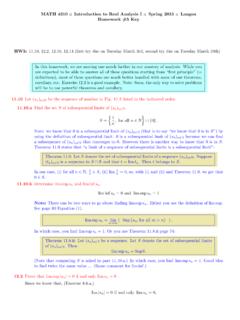Transcription of Chapter 2: Frequency Distributions and Graphs (or making ...
1 Chapter 2: Frequency Distributions and Graphs (or making pretty tables and pretty pictures). Example: Titanic passenger data is available for 1310. individuals for 14 variables, though not all variables are recorded for all individuals. Consider the following variables: Survival, Sex, Number of relatives on board, Age Who wants to stare at a big dataset? If you have 1310 people measured for 14 variables, how much information are we going to get by looking at the data set? See for yourself: That's where tables that summarize the data and Graphs of these summaries come in handy! Ch2: Frequency Distributions and Graphs Santorico -Page 26. Section 2-1 Organizing Data Data must be organized in a meaningful way so that we can use it effectively.
2 This is often a pre-cursor to creating a graph . Frequency distribution the organization of raw data in table form, using classes and frequencies. Class a quantitative or qualitative category. A class may be a range of numerical values (that acts like a category ) or an actual category. Frequency the number of data values contained in a specific class. Ch2: Frequency Distributions and Graphs Santorico -Page 27. There are 3 types of Frequency Distributions : Qualitative Categorical Frequency Distributions Variables Ungrouped Frequency Distributions Quantitative . Variables Grouped Frequency Distributions Let's start with Categorical Frequency Distributions . Frequency distribution for qualitative data.
3 Review: What is qualitative data? Ch2: Frequency Distributions and Graphs Santorico -Page 28. Titanic Example: Survival status and sex are qualitative variables. The following tables give their categorical Frequency Distributions . Survival Status Frequency Sex Frequency Yes 500 Female 466. No 809 Male 843. We'll come back for Graphs which can include a pie graph , bar chart or Pareto chart. Example: Areas of study for students in our class Area of Study Frequency Medical Sciences Public Health Biology Education Geography Other Ch2: Frequency Distributions and Graphs Santorico -Page 29. For quantitative variables we have grouped and ungrouped Frequency Distributions .
4 An Ungrouped Frequency distribution is a Frequency distribution where each class is only one unit wide. Meaningful when the data does not take on many values. Each class is constructed using a single data value for each class, , 0, 1, 2, 3, , 10. Class boundaries will be defined to separate the classes (when graphing) so there are no gaps in the Frequency distribution . o Should have one additional decimal place and end in a 5. o The lower boundary will round to the lower class limit. o The upper boundary will round to the next class o Another way of thinking about this: draw the boundary half way between consecutive classes. Ch2: Frequency Distributions and Graphs Santorico -Page 30.
5 Titanic example: Number of relatives on board Number of Relatives on Board Class Boundaries Frequency 0 790. 1 235. 2 159. 3 43. 4 22. 5 25. 6 16. 7 8. 10 11. Is this an ungrouped Frequency distribution ? Ch2: Frequency Distributions and Graphs Santorico -Page 31. Grouped Frequency distribution Frequency of a quantitative variable with a large range of values, so the data must be grouped into classes that are more than one unit in width. Class Limits Age Group in Years Class Boundaries Frequency Cumulative (Lower, Upper) (Lower, Upper) Frequency 0 4 51 51 Age of 5 9 31 82. 10 14 27 109 Passengers on 15 19 116 225. 20 24 184 409 the Titanic 25 29 160 569. 30 34 132 701 Classified into 35 39 100 801.
6 40 44 69 870. 17 Age Groups 45 49 66 936. 50 54 43 979. with a class 55. 60. 59. 64. 27. 27. 1006. 1033. wide of 5 years 65 69 5 1038. 70 74 6 1044. 75 79 1 1045. 80 84 1 1046. Ch2: Frequency Distributions and Graphs Santorico -Page 32. Guidelines: There should be between 5 and 20 classes. The classes must be mutually exclusive (non- overlapping). Makes placing observations into classes unambiguous. The classes must be continuous. There should be no gaps in the Frequency distribution . The classes must be exhaustive. The classes should accommodate all the data. The classes must be equal in width. Avoids a distorted view of the data. Ch2: Frequency Distributions and Graphs Santorico -Page 33.
7 TERMINOLOGY. Class Limits the range of values to be included in a class. Will have the same decimal place value as the data. Class Boundaries used to separate the classes (when graphing) so there are no gaps in the Frequency distribution . Should have one additional decimal place and end in a 5. The lower boundary will round to the lower class limit. The upper boundary will round to the next class Another way of thinking about this: draw the boundary half way between consecutive classes. Class width found by subtracting the lower class limit of one class from the lower class limit of the next class (OR likewise by subtracting an upper class boundary from the corresponding lower class boundary.)
8 Ch2: Frequency Distributions and Graphs Santorico -Page 34. Steps for Constructing a Grouped Frequency distribution : 1. Determine the classes Find the range of the data = largest value minus the smallest value Find the class width by dividing the range by the number of classes and rounding up. (Add 1 if this value is a whole number). Select a starting point (usually the lowest value); add the width to get the lower limits of all subsequent classes. Find the upper class limit for each class by subtracting 1 unit from the last decimal place of the lower class limit of the next class. o If the lower class limit of the next class is , then the upper class limit for the previous class is o If the lower class limit of the next class is 11, then the upper class limit of the previous class is 10.
9 O If the lower class limit of the next class is , then the upper class limit of the previous class is Find the boundaries. 2. Tally (count) the data in each class. 3. Find the numerical frequencies from the tallies. Ch2: Frequency Distributions and Graphs Santorico -Page 35. Titanic Example: Ages of passengers in first class 1 2 4 6 11 13 14 15 16 16 16 17 17 17 17 18 18 18 18 18 18 19 19 19. 19 19 21 21 21 21 21 22 22 22 22 22 22 22 23 23 23 23 23 23 24 24 24 24. 24 24 24 24 24 25 25 25 25 25 26 26 26 27 27 27 27 27 27 27 28 28 28 28. 28 28 29 29 29 29 30 30 30 30 30 30 30 30 30 30 30 31 31 31 31 31 31. 31 32 32 32 33 33 33 33 33 33 33 34 35 35 35 35 35 35 35 35 35 35 35.
10 36 36 36 36 36 36 36 36 36 36 36 36 37 37 37 37 37 38 38 38 38 38 38. 39 39 39 39 39 39 39 39 39 40 40 40 40 40 41 41 41 42 42 42 42 42 42 42. 43 43 43 44 44 44 45 45 45 45 45 45 45 45 45 45 45 46 46 46 46 46 46 47. 47 47 47 47 47 47 47 48 48 48 48 48 48 48 48 48 49 49 49 49 49 49 49 50. 50 50 50 50 50 50 50 51 51 51 51 52 52 52 52 53 53 53 53 54 54 54 54. 54 54 55 55 55 55 55 55 55 56 56 56 56 57 57 58 58 58 58 58 58 59 60. 60 60 60 60 61 61 61 62 62 62 63 63 64 64 64 64 64 65 65 67 70 71 71 76. 80. Ch2: Frequency Distributions and Graphs Santorico -Page 36. Let's use 8 age classes: Class Class Cumulative Limits Boundaries Frequency Frequency Sanity check: make sure that the last cumulative Frequency actually matches with the number of observations!








